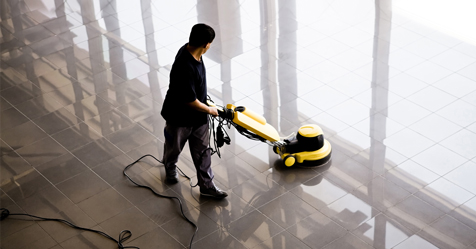In many facilities, with the springtime thaw and a change in seasons comes a routine strip and refinish of resilient floors that received heavy traffic, tracked-in snow, ice-melters and other soils during the winter months.
Many consider stripping the most unpleasant part of the refinishing process because of the harsh chemicals and odor. With the right products and procedures, it doesn’t have to be so unpleasant.
Manufacturers are creating effective stripping products that are safe for their employees and friendly to the environment.
The chemicals that make traditional floor finish strippers work can, under the right circumstances, make those exposed to them feel a variety of ill effects.
Beware of butyl
Floor finish strippers made with butoxyethanol — commonly know as “butyl” — are cheap, effective, and easy to formulate. But they can also be corrosive to both the skin and eyes.
Butyl strippers can also cause serious, sometimes permanent damage when inhaled or ingested.
Besides the potential contact hazards, butyl-containing floor finish strippers can emit an unpleasant odor, causing a burning sensation to those exposed to the fumes, particularly in poorly ventilated areas.
Fortunately for floor care professionals, some floor finish strippers in the market are now safe, affordable and low-odor.
When selecting from among new low-odor options, floor care professionals can chose products that are butyl-free, effective across a wide range of floor finishes and weather conditions, and economical.
Even if a product is low-cost, it is not economical if it requires application at a higher rate than competing products.
Not all floor finish strippers are created equal, and one way to choose from the many products on the market is to look to the manufacturers.
Established companies are more likely to have the expertise and resources to develop safe and effective products.
In addition, federal law requires manufacturers to provide material safety data sheets (MSDS) for each product they sell. These documents indicate whether the floor finish stripper contains butyl or has the potential to cause “non-reversible side effects.”
Secrets to stripping success
After selecting a safe and effective stripping product, floor care professionals can follow these simple steps for effective floor finish removal:
- Dilute the stripping product according to manufacturer instructions. Using a dilution higher than the recommended rate does not necessarily ensure better performance and can potentially make stripping more difficult by promoting dry-back of the stripper. Also, almost all product manufacturers recommend floor care professionals wear safety goggles and gloves at all times when handling product, regardless of how safe and low-odor it is.
- Mop the floor finish stripper on the floor and give the product at least 10 minutes to penetrate the floor finish. Rushing to remove the stripping product from the floor before it has enough time to work can cause rework.
- When the stripping product is on the floor, add additional stripper as needed to keep the floor evenly wet. If the floor is allowed to dry in certain places, it can negatively impact the effectiveness of the stripper.
- After the product has penetrated the finish, agitate it with an autoscrubber or burnisher equipped with a black pad to detach it from the floor. Remove all finish and liquid with a wet vacuum, but not until the finish is completely liquefied.
- Finally, make sure to remove all old floor finish and stripping product residue before applying the new floor finish. Stripper residue can affect durability, and leftover finish can affect the appearance and smoothness of the fresh coat of finish.
Stripping a finished floor can be one of the most unpleasant tasks in floor care, but by choosing safe, effective and low-odor products and using correct procedures, the process doesn’t have to be a dreaded task.


